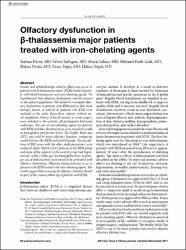Olfactory Dysfunction in -Thalassemia Major Patients Treated with Iron-Chelating Agents

Göster/
Tarih
2017Yazar
Derin, SerhanErdoğan, Selvet
Şahan, Murat
Azik, Mehmet Fatih
Derin, Hatice
Topal, Yaşar
Topal, Hatice
Üst veri
Tüm öğe kaydını gösterÖzet
Ocular and ophthalmologic adverse effects may occur in patients with -thalassemia major (BTM) treated regularly with blood transfusions and iron-chelating agents. We hypothesized that olfactory dysfunction may be present in this patient population. We aimed to investigate olfactory dysfunction in patients with BTM and to determine etiologic factors. A total of 43 patients with BTM were included in the study. Forty-three subjects without nasal complaints, history of facial trauma, or nasal surgery were included as the controls. All participants had nasal endoscopy. The use of iron-chelating agents by patients with BTM and their duration of use were recorded, as well as hemoglobin and ferritin levels. The Sniffin Sticks test (SST) was used to assess olfactory function, comparing results between the BTM and control groups. The correlations of SST scores with the other study parameters were analyzed. Eight (18.6%) of 43 patients in the BTM group and none of the subjects in the control group had hyposmia (p < 0.001). Older age, low hemoglobin level, and longer use of deferoxamine were found to be correlated with olfactory dysfunction. Olfactory dysfunction can occur in patients with BTM treated with iron-chelating agents. The results suggest that screening for olfactory function should be part of the routine follow-up of patients with BTM.

















